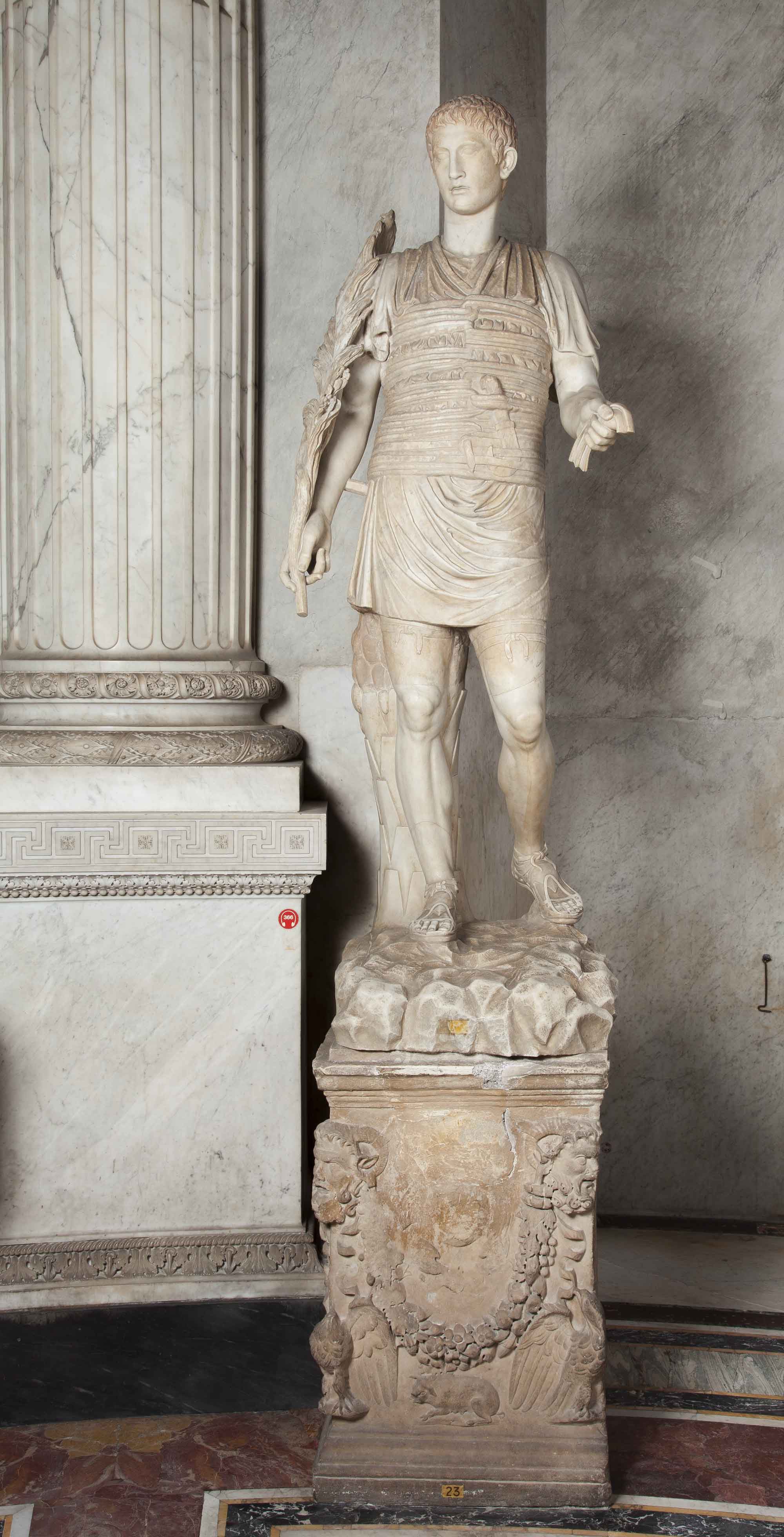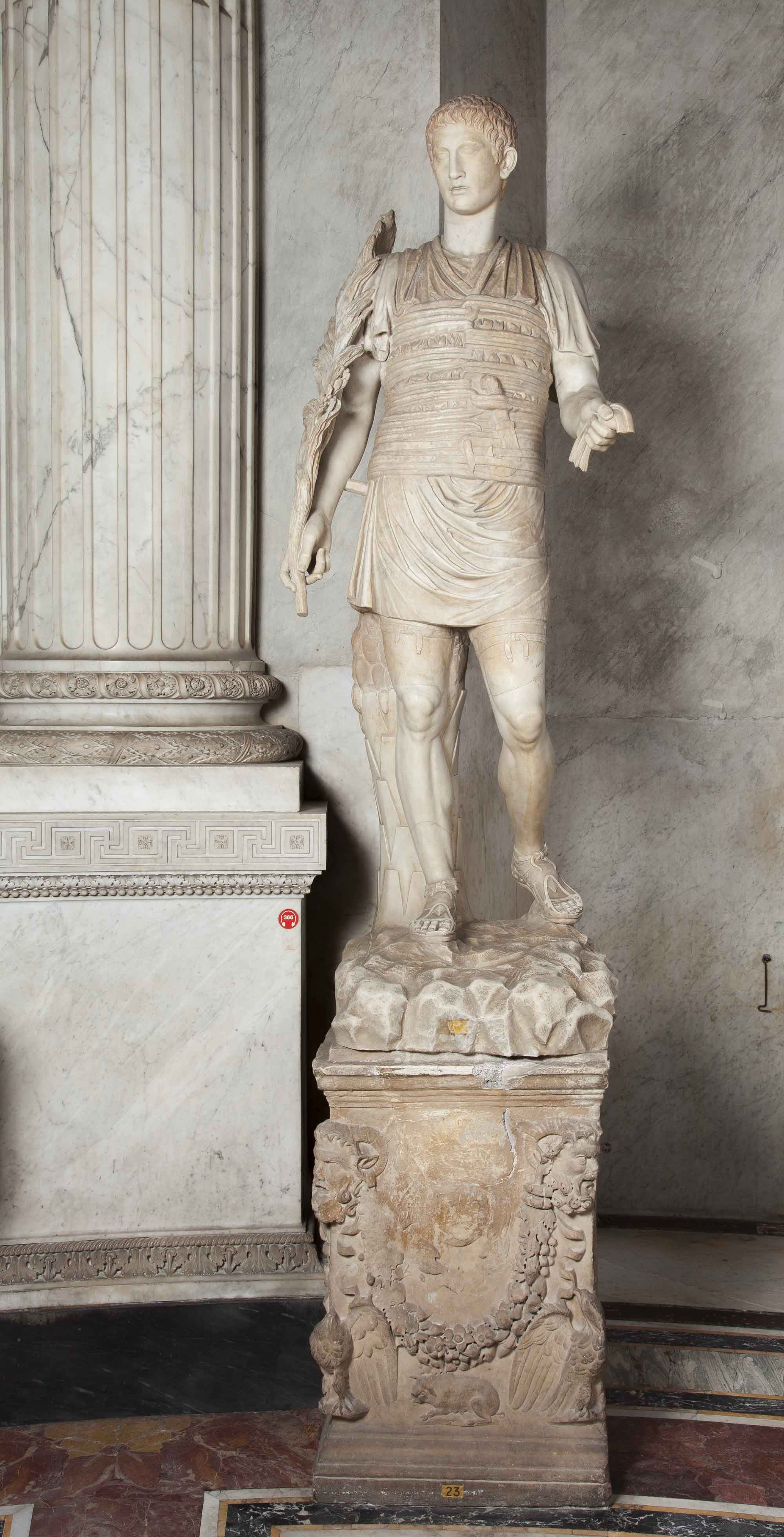Ancient Statue of Charioteer; private collection of Sixstus V & Funerary Altar
Artist: Unknown
Date: Second half of I century A.D. - additions from late XVIII century
Classification: Sculpture
Dimensions: 184 cm
Materials: Fine-grained white marble
Adopted By: The California Chapter
Total Cost: $ 17,200
Description
This sculpture is on display in the scenic Biga Hall close to the entrance of the Gallery of the Candelabras. It depicts a charioteer as evidenced by the figure’s specific clothing, which includes a short tunic banded with leather up to chest height. This sort of bodice had the function of protecting the body from shock during chariot races. Sharp movements common in races could result in rib fractures and other serious injuries. A curved sickle was traditionally caught between the leather bands and the reins, which were also wrapped around the torso. The sickle served to cut the reins if the carts were to overturned, preventing the charioteer from being dragged along. Originally, the dress would have been painted in one of the circus's team colors: red (russata), whites (albata), green (prasina), or blue (veneta). This statue was sold to the papal collection in 1785 by Mr. Thomas Jenkins. The original location of the statue was the villa Peretti Montalto, the magnificent private residence of Cardinal Felice Peretti, who later became Pope Sixtus V (1585-1590). Cardinal Peretti built this elaborate villa between the Viminale and the Esquiline hills, near the ancient Baths of Diocletian. The Vatican Museums have on display many of the sculptures that originally formed part of this important collection of Cardinal Peretti, including the colossal marble statue of the Dacian Prince, which was recently restored thanks to the generosity of the Patrons of the Arts of the Colorado Chapter. Throughout its long history, this statue has undergone several restorations. The head, though ancient, did not originally belong to the statue and was added at the time the sculpture entered the Pope’s collection. The legs and arms, which show the palm and the “mappa” (a cloth, used to give the starting sign during the races), date back to the late 18th-century restoration.
Through the study of documents, engravings, and drawings from the 1600 century (contained in the Album Montalto 1623-1631), it is apparent that the statue looked different when it was located in Villa Peretti Montalto. It is possible that this ancient statue was provided with a palm, the ancient symbol of victory in the competition. Unfortunately, it is not possible to trace the exact origin of the statue because there are not many examples of this same iconography. Recently, some scholars have suggested that this sculpture forms part of a group of Hermam with portraits of charioteers found near the train station of Trastevere at the end of the 19th century. This area was anciently known as the area of the Horti of Ceasar, where originally was a small shrine dedicated to Hercules, the patron of athletes and the hero of competitions. While this theory is not certain, it is nice to think about the possibility that our statue comes from this shrine and originally served as an “ex-voto” offered by a Charioteer to Hercules ingratitude of the protection granted by the mythical hero on the occasion of the circus games. At the time of its location in the Biga Hall, the statue of the Auriga was placed on a funerary altar found in the mid-18th century near Pozzuoli in Campania. The altar is decorated at the corners by two heads of Ammon, whose horns are hung with garlands of fruit, below are represented two eagles with widely spread wings. On each side of the altar are typical funerary motifs from the second half of the 1st century AD: figures of small cupids, birds shown in their nest or in the process of capturing a butterfly, a pig, and a calf. The inscription indicates that this altar was dedicated by Numerius Naevius Moschus “augustalis”, (priest of the imperial cult) of Puteoli, the ancient name for Pozzuoli, to “his sweet child Numerius Naevius Vitulus and his dearest wife Naevia Saturnina”.
State of Preservation
The works are covered with a thick layer of dirt and greasy dust that obscure the real appearance of the statues and impede their purely aesthetic enjoyment. The original marble is fairly well preserved, but has some areas with increased porosity and variation of surface texture due to previous cleanings. Additionally, the old protective layer no longer used in restoration, has damaged the surface.
Restoration Procedures
- Photographic documentation of the state of conservation
- Development of cleaning systems that allows for the gradual removal of dust an dirt depostis. The lightening of stains that have penetrated the marble, where possible, through the use of a specific absorbent paste, or other established chemical means
- Check the tightness of restoration bolts and stabilization inserts with specific adhesives or by reactivating adhesives made in previous restorations
Detail
Adopted By:
The California ChapterInventory N°: 2344
Artist: Unknown
Date: Second half of I century A.D. - additions from late XVIII century
Dimensions: 184 cm
Materials: Fine-grained white marble
Wishbook year: 2016
Total Cost
$ 17,200

Ancient Statue of Charioteer; private collection of Sixstus V & Funerary Altar

Details
Adopted by: The California Chapter
Inventory: 2344
Artist: Unknown
Date: Second half of I century A.D. - additions from late XVIII century
Classification: Sculpture
Materials: Fine-grained white marble
Dimensions: 184 cm
Museum: Chiaramonti Museum
Department: Greek and Roman Antiquities
Laboratory: Stone Materials
Wishbook year: 2016
Description
This sculpture is on display in the scenic Biga Hall close to the entrance of the Gallery of the Candelabras. It depicts a charioteer as evidenced by the figure’s specific clothing, which includes a short tunic banded with leather up to chest height. This sort of bodice had the function of protecting the body from shock during chariot races. Sharp movements common in races could result in rib fractures and other serious injuries. A curved sickle was traditionally caught between the leather bands and the reins, which were also wrapped around the torso. The sickle served to cut the reins if the carts were to overturned, preventing the charioteer from being dragged along. Originally, the dress would have been painted in one of the circus's team colors: red (russata), whites (albata), green (prasina), or blue (veneta). This statue was sold to the papal collection in 1785 by Mr. Thomas Jenkins. The original location of the statue was the villa Peretti Montalto, the magnificent private residence of Cardinal Felice Peretti, who later became Pope Sixtus V (1585-1590). Cardinal Peretti built this elaborate villa between the Viminale and the Esquiline hills, near the ancient Baths of Diocletian. The Vatican Museums have on display many of the sculptures that originally formed part of this important collection of Cardinal Peretti, including the colossal marble statue of the Dacian Prince, which was recently restored thanks to the generosity of the Patrons of the Arts of the Colorado Chapter. Throughout its long history, this statue has undergone several restorations. The head, though ancient, did not originally belong to the statue and was added at the time the sculpture entered the Pope’s collection. The legs and arms, which show the palm and the “mappa” (a cloth, used to give the starting sign during the races), date back to the late 18th-century restoration.
Through the study of documents, engravings, and drawings from the 1600 century (contained in the Album Montalto 1623-1631), it is apparent that the statue looked different when it was located in Villa Peretti Montalto. It is possible that this ancient statue was provided with a palm, the ancient symbol of victory in the competition. Unfortunately, it is not possible to trace the exact origin of the statue because there are not many examples of this same iconography. Recently, some scholars have suggested that this sculpture forms part of a group of Hermam with portraits of charioteers found near the train station of Trastevere at the end of the 19th century. This area was anciently known as the area of the Horti of Ceasar, where originally was a small shrine dedicated to Hercules, the patron of athletes and the hero of competitions. While this theory is not certain, it is nice to think about the possibility that our statue comes from this shrine and originally served as an “ex-voto” offered by a Charioteer to Hercules ingratitude of the protection granted by the mythical hero on the occasion of the circus games. At the time of its location in the Biga Hall, the statue of the Auriga was placed on a funerary altar found in the mid-18th century near Pozzuoli in Campania. The altar is decorated at the corners by two heads of Ammon, whose horns are hung with garlands of fruit, below are represented two eagles with widely spread wings. On each side of the altar are typical funerary motifs from the second half of the 1st century AD: figures of small cupids, birds shown in their nest or in the process of capturing a butterfly, a pig, and a calf. The inscription indicates that this altar was dedicated by Numerius Naevius Moschus “augustalis”, (priest of the imperial cult) of Puteoli, the ancient name for Pozzuoli, to “his sweet child Numerius Naevius Vitulus and his dearest wife Naevia Saturnina”.
State of Preservation
The works are covered with a thick layer of dirt and greasy dust that obscure the real appearance of the statues and impede their purely aesthetic enjoyment. The original marble is fairly well preserved, but has some areas with increased porosity and variation of surface texture due to previous cleanings. Additionally, the old protective layer no longer used in restoration, has damaged the surface.
Restoration Procedures
- Photographic documentation of the state of conservation
- Development of cleaning systems that allows for the gradual removal of dust an dirt depostis. The lightening of stains that have penetrated the marble, where possible, through the use of a specific absorbent paste, or other established chemical means
- Check the tightness of restoration bolts and stabilization inserts with specific adhesives or by reactivating adhesives made in previous restorations
Media

Ancient Statue of Charioteer; private collection of Sixstus V & Funerary Altar

© 2025 Patrons of the Arts
in the Vatican Museums
Vatican Museums V-00120,
Vatican City State (Europe)
+39 0669864499
